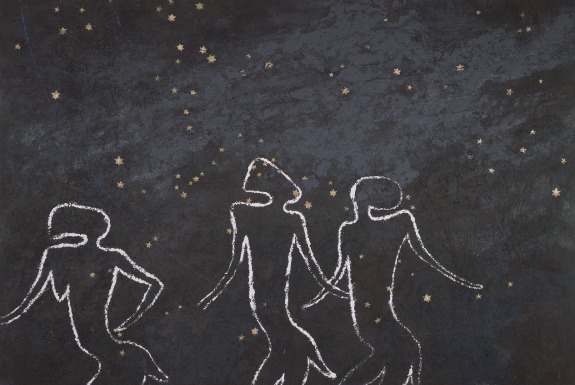Seeing Stars at the African Art Museum
“African Cosmos: Stellar Arts” opens today at the African Art Museum
Contemporary artist Gavin Jantjes evokes South African cave paintings in this untitled work. Image courtesy of the African Art Museum.
Upon entering the African Art Museum’s new exhibition, “African Cosmos: Stellar Arts,” for the first time, Johnnetta B. Cole, director of the African Art Museum, was abruptly transported back to the evenings of her childhood in Jacksonville, Florida.
“I would go through a ritual each and every night that we were allowed to stay up a little late and play outside,” she recalled at the exhibition press preview. “I would look up to the sky and say something I suspect little girls and boys in multiple languages around the world say: Star light, star bright, first star I see tonight. I wish I may, I wish I might, have the wish I wish tonight.”
This universal wonder inspired by the night sky is at the heart of “African Cosmos,” which opened yesterday and will be on view through December 9. The opening coincides with a recent announcement that South Africa and eight other African partners will host the radio telescope-based Square Kilometre Project, which will “literally probe the early origins of the universe,” according to Derek Hanekom, the Deputy Minister of Science and Technology in South Africa.
The cavernous gallery houses a hundred artifacts of “cultural astronomy,” as curator Christine Mullen Kreamer puts it, in the form of cosmos-related African artwork from ancient Egypt and Nubia to present day. The diverse body of work breaks away from the Western and scientific conception of the universe to tell a different narrative of cosmic understanding. This narrative encompasses many different interpretations of the sky over time, including the Yoruba depiction of the universe as a lidded vessel, burial paintings of the Egyptian sky goddess Nut, and a 1990 painting by South African artist Gavin Jantjes linking the continent’s staple foods like yams, cassava, barley and rice with the movement of the river constellation Eridanus, which appears before the Nile floods.
A cornerstone of the exhibition is a video installation by South African artist Karel Nel as part of COSMOS, a Caltech astronomy project mapping a two-degree square area of the universe. The video zooms in towards the center of the universe and back out again, as a chorus of African crickets chirps. Nel was struck by how the crickets that would sing outside his studio at night sounded like “deep space.” The chirps are then played backwards, transformed into eerie, alien-like clicks.
Why is this Afro-centric narrative of the universe so important? Primarily, the exhibition wants visitors to “understand Africa’s role in the history of knowledge over time,” says curator Mullen Kreamer.
This reclaimed role in building knowledge is especially relevant now, in light of the decision to install the bulk of the Square Kilometre Project in South Africa. The army of radio telescopes will trace faint radio signals to map the evolution of the universe and determine the positions of the nearest billion galaxies. Most of the 3,000 telescopes will be installed in the semi-arid regions of South Africa, where there is little interference from cell phone towers or TV broadcast. Hanekom, who was present at the opening, emphasized the significance of the move.
“It is an expression of confidence in African scientific capabilities such as we’ve never seen before,” Hanekom says. “This is going to be a catalyst. It will take us from a continent seen to be riddled with poverty and underdevelopment to a continent that will have a major offer to make to global knowledge.”
“African Cosmos” can help contextualize this project within the long tradition of African sky-watching. The museum also hopes it will open the minds of children who may feel intimidated by technology. “Science, engineering and technology for some communities has become something so foreign, so complicated; something that young children simply do not want to relate to,” Director Cole says. But as she well knows, every child can relate to that instinctive desire to wish upon a star.
African Cosmos: Stellar Art is on display through December 9.
/https://tf-cmsv2-smithsonianmag-media.s3.amazonaws.com/accounts/headshot/ATM-aviva-shen-240.jpg)

/https://tf-cmsv2-smithsonianmag-media.s3.amazonaws.com/accounts/headshot/ATM-aviva-shen-240.jpg)